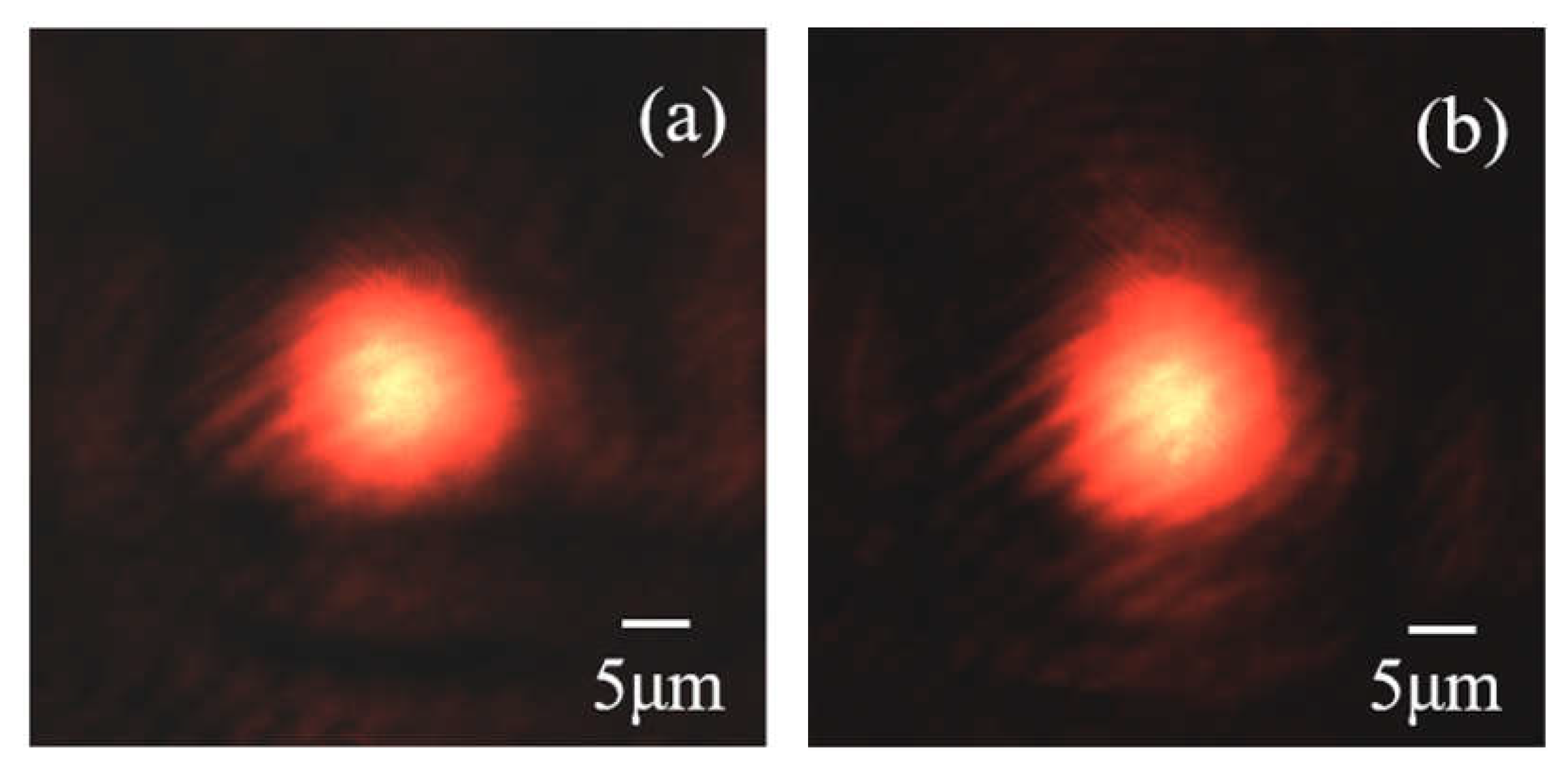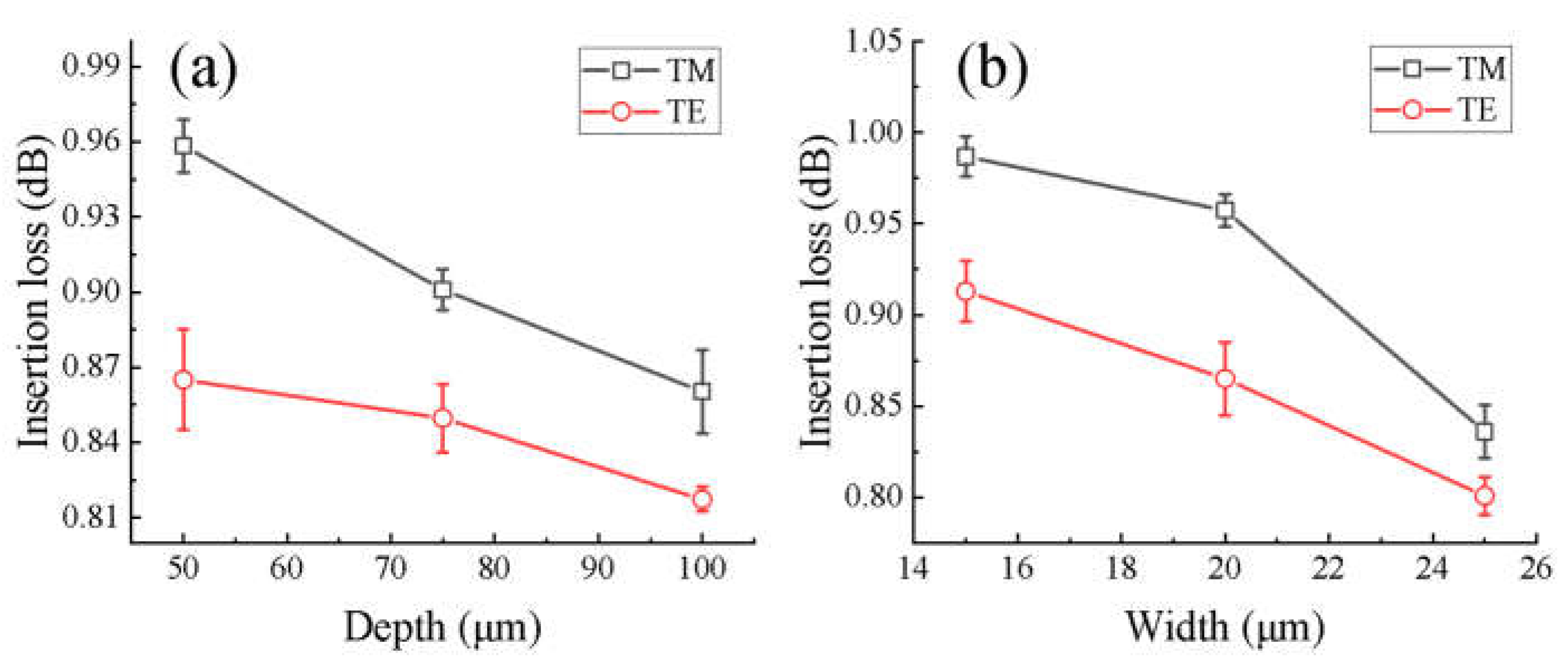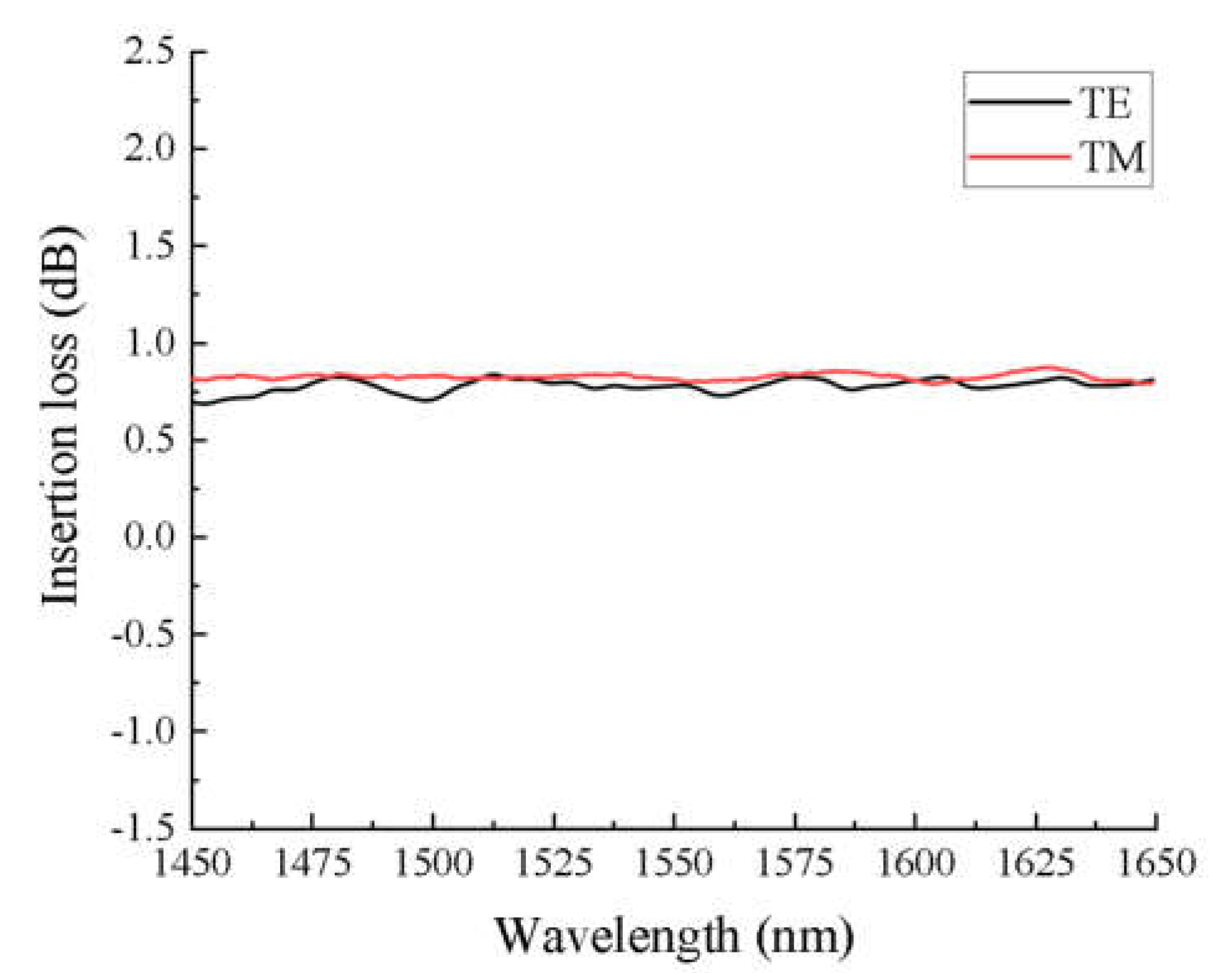Bending 90° Waveguides in Nd:YAG Crystal Fabricated by a Combination of Femtosecond Laser Inscription and Precise Diamond Blade Dicing
Abstract
1. Introduction
2. Fabrication Method
3. Results and Discussion
4. Conclusions
Author Contributions
Funding
Institutional Review Board Statement
Informed Consent Statement
Data Availability Statement
Acknowledgments
Conflicts of Interest
References
- Lv, J.; Cheng, Y.; Lu, Q.; de Aldana, J.R.V.; Hao, X.; Chen, F. Femtosecond laser written optical waveguides in z-cut MgO:LiNbO3 crystal: Fabrication and optical damage investigation. Opt. Mater. 2016, 57, 169–173. [Google Scholar] [CrossRef]
- Apostolopoulos, V.; Laversenne, L.; Colomb, T.; Depeursinge, C.; Salathé, R.; Pollinau, M.; Osellame, R.; Cerullo, G.; Laporta, P. Femtosecond-irradiation-induced refractive-index changes and channel waveguiding in bulk Ti3+: Sapphire. Appl. Phys. Lett. 2004, 85, 1122–1124. [Google Scholar] [CrossRef]
- Jia, Y.; Wang, S.; Chen, F. Femtosecond laser direct writing of flexibly configured waveguide geometries in optical crystals: Fabrication and application. Opto-Electron. Adv. 2020, 3, 190042. [Google Scholar] [CrossRef]
- Sun, X.; Dong, X.; Hu, Y.; Li, H.; Chu, D.; Zhou, J.; Wang, C.; Duan, J.A. A robust high refractive index sensitivity fiber Mach–Zehnder interferometer fabricated by femtosecond laser machining and chemical etching. Sens. Actuat. A-Phys. 2015, 230, 111–116. [Google Scholar] [CrossRef]
- Ringleb, S.; Rademaker, K.; Nolte, S.; Tünnermann, A. Monolithically integrated optical frequency converter and amplitude modulator in LiNbO3 fabricated by femtosecond laser pulses. Appl. Phys. B-Lasers O 2010, 102, 59–63. [Google Scholar] [CrossRef]
- Liao, Y.; Xu, J.; Cheng, Y.; Zhou, Z.H.; He, F.; Sun, H.Y.; Song, J.; Wang, X.S.; Xu, Z.Z.; Sugioka, K.; et al. Electro-optic integration of embedded electrodes and waveguides in LiNbO3 using a femtosecond laser. Opt. Lett. 2008, 33, 2281–2283. [Google Scholar] [CrossRef] [PubMed]
- Ling, T.; Liu, L.; Song, Q.; Xu, L.; Wang, W. Intense directional lasing from a deformed square-shaped organic-inorganic hybrid glass microring cavity. Opt. Lett. 2003, 28, 1784–1786. [Google Scholar] [CrossRef] [PubMed]
- Skryabin, N.; Kalinkin, A.; Dyakonov, I.; Kulik, S. Femtosecond laser written depressed-cladding waveguide 2 × 2, 1 × 2 and 3 × 3 directional couplers in Tm3+:YAG crystal. Micromachines 2019, 11, 1. [Google Scholar] [CrossRef] [PubMed]
- Zhao, L.; Jiang, L.; Wang, S.; Xiao, H.; Lu, Y.; Tsai, H.L. A high-quality Mach-Zehnder interferometer fiber sensor by femtosecond laser one-step processing. Sensors 2011, 11, 54–61. [Google Scholar] [CrossRef] [PubMed]
- Feng, T.; Sahoo, P.; Arteaga-Sierra, F.; Dorrer, C.; Qiao, J. Pulse-propagation modeling and experiment for femtosecond-laser writing of waveguide in Nd:YAG. Crystals 2019, 9, 434. [Google Scholar] [CrossRef]
- Ródenas, A.; Torchia, G.A.; Lifante, G.; Cantelar, E.; Lamela, J.; Jaque, F.; Roso, L.; Jaque, D. Refractive index change mechanisms in femtosecond laser written ceramic Nd:YAG waveguides: Micro-spectroscopy experiments and beam propagation calculations. Appl. Phys. B-Lasers O 2009, 95, 85–96. [Google Scholar] [CrossRef]
- Pätzold, W.M.; Demircan, A.; Morgner, U. Low-loss curved waveguides in polymers written with a femtosecond laser. Opt. Express 2017, 25, 263–270. [Google Scholar] [CrossRef] [PubMed]
- Wang, Y.; Dai, D. Multimode silicon photonic waveguide corner-bend. Opt. Express 2020, 28, 9062–9071. [Google Scholar] [CrossRef]
- Lv, J.; Bai, J.; Zhou, K.M.; Mei, X.S.; Wang, K.D.; Li, M.; Cheng, G.H. Transmission performance of 90 degrees-bend optical waveguides fabricated in fused silica by femtosecond laser inscription. Opt. Lett. 2017, 42, 3470–3473. [Google Scholar] [CrossRef] [PubMed]
- Bruske, D.; Suntsov, S.; Ruter, C.E.; Kip, D. Efficient ridge waveguide amplifiers and lasers in Er-doped lithium niobate by optical grade dicing and three-side Er and Ti in-diffusion. Opt. Express 2017, 25, 29374–29379. [Google Scholar] [CrossRef]
- Wang, Y.; Shen, X.L.; Zhu, Q.F.; Liu, C.X. Optical planar and ridge waveguides in terbium gallium garnet crystals produced by ion implantation and precise diamond blade dicing. Opt. Mater. Express 2018, 8, 3288–3294. [Google Scholar] [CrossRef]
- Sun, J.; Gan, Y.C.; Xu, C. Efficient green-light generation by proton-exchanged periodically poled MgO:LiNbO3 ridge waveguide. Opt. Lett. 2011, 36, 549–551. [Google Scholar] [CrossRef]
- Courjal, N.; Guichardaz, B.; Ulliac, G.; Rauch, J.Y.; Sadani, B.; Lu, H.; Bernal, M.P. High aspect ratio lithium niobate ridge waveguides fabricated by optical grade dicing. J. Phys. D Appl. Phys. 2011, 44, 305101. [Google Scholar] [CrossRef]
- Volk, M.F.; Suntsov, S.; Rüter, C.E.; Kip, D. Low loss ridge waveguides in lithium niobate thin films by optical grade diamond blade dicing. Opt. Express 2016, 24, 1386–1391. [Google Scholar] [CrossRef]
- Suntsov, S.; Rüter, C.E.; Kip, D. Dual parameter fiber-integrated sensor for refractive index and temperature measurement based on Fabry–Perot micro-resonators. Appl. Opt. 2019, 58, 2076–2080. [Google Scholar] [CrossRef]
- Suntsov, S.; Rüter, C.E.; Schipkowski, T.; Kip, D. Fiber-integrated refractive index sensor based on a diced Fabry–Perot micro-resonator. Appl. Opt. 2017, 56, 9139–9143. [Google Scholar] [CrossRef] [PubMed]
- Calmano, T.; Paschk, A.G.; Müller, S.; Kränkel, C.; Huber, G. Curved Yb:YAG waveguide lasers, fabricated by femtosecond laser inscription. Opt. Express 2013, 21, 25501–25508. [Google Scholar] [CrossRef] [PubMed]
- Wu, P.F.; Yang, S.C.; Ren, Y.Y.; Liu, H.L. Beam splitters fabricated by nonlinear focusing of femtosecond laser writing in pure YAG crystal. Front. Phys. 2021, 9, 719757. [Google Scholar] [CrossRef]
- Zhang, C.; Dong, N.; Yang, J.; Chen, F.; de Aldana, J.R.V.; Lu, Q. Channel waveguide lasers in Nd:GGG crystals fabricated by femtosecond laser inscription. Opt. Express 2011, 19, 12503–12508. [Google Scholar] [CrossRef] [PubMed]
- Li, S.L.; Ye, Y.K.; Wang, M.W. Femtosecond laser written channel optical waveguide in Nd:YAG crystal. Opt. Laser Technol. 2014, 58, 89–93. [Google Scholar] [CrossRef]
- Li, S.L.; Han, P.G.; Shi, S.; Yao, Y.C.; Hu, B.; Wang, M.W.; Zhu, X.N. Low-loss channel optical waveguide fabrication in Nd3+-doped silicate glasses by femtosecond laser direct writing. Opt. Express 2011, 19, 23958–23964. [Google Scholar] [CrossRef]
- Siebenmorgen, J.; Petermann, K.; Huber, G.; Rademaker, K.; Nolte, S.; Tünnermann, A. Femtosecond laser written stress-induced Nd:Y3Al5O12 (Nd:YAG) channel waveguide laser. Appl. Phys. B 2009, 97, 251. [Google Scholar] [CrossRef]
- Zhang, Y.; Wu, J.; Wang, L.; Chen, F. Femtosecond laser direct writing of Nd:YAG waveguide with Type I modification: Positive refractive index change in track. Opt. Mater. 2021, 113, 110844. [Google Scholar] [CrossRef]
- Sun, X.; Sun, S.; Romero, C.; de Aldana, J.R.V.; Liu, F.; Jia, Y.; Chen, F. Femtosecond laser direct writing of depressed cladding waveguides in Nd:YAG with “ear-like” structures: Fabrication and laser generation. Opt. Express 2021, 29, 4296–4307. [Google Scholar] [CrossRef]
- Beresna, M.; Gecevičius, M.; Lancry, M.; Poumellec, B.; Kazansky, P.G. Broadband anisotropy of femtosecond laser induced nanogratings in fused silica. Appl. Phys. Lett. 2013, 103, 131903. [Google Scholar] [CrossRef]
- Ji, L.; Sun, X.; He, G.; Liu, Y.; Wang, X.; Yi, Y.; Chen, C.; Wang, F.; Zhang, D. Surface plasmon resonance refractive index sensor based on ultraviolet bleached polymer waveguide. Sens. Actuat. B-Chem. 2017, 244, 373–379. [Google Scholar] [CrossRef]
- Chen, L.; Liu, B.; Liu, J.; Yuan, J.H.; Chan, H.P.; Wu, T.; Wang, M.Y.; Wan, S.P.; He, X.D.; Wu, Q. U-shape panda polarization-maintaining microfiber sensor coated with graphene oxide for relative humidity measurement. J. Lighwave Technol. 2021, 39, 6308–6314. [Google Scholar] [CrossRef]
- Wang, J.; Munir, A.; Li, Z. Aptamer-Au NPs conjugates-enhanced SPR sensing for the ultrasensitive sandwich immunoassay. Biosens. Bioelectron. 2009, 25, 124–129. [Google Scholar] [CrossRef] [PubMed]









| Serial Number | WG1 | WG2 | WG3 |
|---|---|---|---|
| Group 1 | W = 20 µm D = 50 µm | W = 20 µm D = 75 µm | W = 20 µm D = 100 µm |
| Group 2 | W = 15 µm D = 50 µm | W = 20µm D = 50 µm | W = 25 µm D = 50 µm |
Disclaimer/Publisher’s Note: The statements, opinions and data contained in all publications are solely those of the individual author(s) and contributor(s) and not of MDPI and/or the editor(s). MDPI and/or the editor(s) disclaim responsibility for any injury to people or property resulting from any ideas, methods, instructions or products referred to in the content. |
© 2023 by the authors. Licensee MDPI, Basel, Switzerland. This article is an open access article distributed under the terms and conditions of the Creative Commons Attribution (CC BY) license (https://creativecommons.org/licenses/by/4.0/).
Share and Cite
Zha, H.; Yao, Y.; Wang, M.; Chen, N.; Zhang, L.; Bai, C.; Liu, T.; Ren, Y.; Jia, Y. Bending 90° Waveguides in Nd:YAG Crystal Fabricated by a Combination of Femtosecond Laser Inscription and Precise Diamond Blade Dicing. Crystals 2023, 13, 188. https://doi.org/10.3390/cryst13020188
Zha H, Yao Y, Wang M, Chen N, Zhang L, Bai C, Liu T, Ren Y, Jia Y. Bending 90° Waveguides in Nd:YAG Crystal Fabricated by a Combination of Femtosecond Laser Inscription and Precise Diamond Blade Dicing. Crystals. 2023; 13(2):188. https://doi.org/10.3390/cryst13020188
Chicago/Turabian StyleZha, Hao, Yicun Yao, Minghong Wang, Nankuang Chen, Liqiang Zhang, Chenglin Bai, Tao Liu, Yingying Ren, and Yuechen Jia. 2023. "Bending 90° Waveguides in Nd:YAG Crystal Fabricated by a Combination of Femtosecond Laser Inscription and Precise Diamond Blade Dicing" Crystals 13, no. 2: 188. https://doi.org/10.3390/cryst13020188
APA StyleZha, H., Yao, Y., Wang, M., Chen, N., Zhang, L., Bai, C., Liu, T., Ren, Y., & Jia, Y. (2023). Bending 90° Waveguides in Nd:YAG Crystal Fabricated by a Combination of Femtosecond Laser Inscription and Precise Diamond Blade Dicing. Crystals, 13(2), 188. https://doi.org/10.3390/cryst13020188






